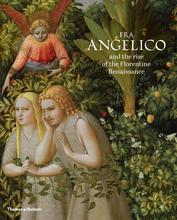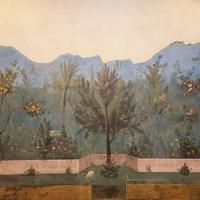More about Annunciation
- All
- Info
- Shop

Contributor
If you’ve ever taken Art History 101, you’ve seenThe Annunciation by Fra Angelico.
Not only is this one of the most famous examples of Italian Renaissance art, but it’s also just one of the most famous works of art, period. If it’s not obvious, it the scene where the Angel Michael tells Mary that she’s going to have a baby even though she’s never done the dirty.
This painting is not famous because it is particularly skillfully done – it was done early on in the Renaissance, so the proportions are actually a bit off. If Mary were to stand up right now, she would smack her face on the ceiling because she is so tall. This painting is amazing in a lot of other ways. For instance, you’ll see that the vanishing point of the painting looks unnatural, but that’s because this painting is placed at the top of a staircase at the San Marco Museum in Florence, Italy. The vanishing point doesn’t make sense if you’re standing right in front of the piece at eye-level, but it does make sense when you look at it from the bottom of the stairs.
Also because this piece was commissioned in 1440 by the Medici family, it contains some extraordinary materials that actually make the piece shimmer as you walk by. Nothing but the best for the Medicis, am I right? This piece was painted on the walls as the entire building was being renovated by the architect, Michelozzo di Bartolomeo. (Fun fact: this renovation included the building of the first library since antiquity.) Another cool thing about this painting is that it looks like it is set in the actual San Marco monastery. If it had been painted more realistically, then people might even have thought that the top of the stairs led to an outdoor space, but unfortunately Photorealism wouldn’t arrive on the scene for a few more centuries.
This piece doesn’t have all of the symbols that usually fill an Annunciation scene, like white lilies to signify Mary’s virginity, or a Bible to symbolize her piousness. No, this work was made for the eyes of monks only, who knew this story like the back of their hand. They didn’t need to have anything hinted to them because they were experts. The bottom of the painting is inscribed with some long-winded Latin phrase that boils down to a reminder to pray everyday. Though I'm sure the monks did not need the reminder.
Sources
- Glover, Michael. "Great Works: Annunciation (1438-45), Fra Angelico." The Independent. N.p., 2010. Web. 7 Nov. 2018. https://www.independent.co.uk/arts-entertainment/art/great-works/great-…
- Harris, Beth, and Steven Zucker. Fra Angelico, The Annunciation. Florence: Khan Academy. Video. https://www.khanacademy.org/humanities/renaissance-reformation/early-re…
- "The Annunciation, Fra Angelico: Analysis Of Painting, Interpretation." Visual-arts-cork.com. Web. 7 Nov. 2018. http://www.visual-arts-cork.com/famous-paintings/annunciation-fra-angel…
Featured Content
Here is what Wikipedia says about Annunciation (Fra Angelico, San Marco)
The Annunciation (c. 1440–1445) is an Early Renaissance fresco by Fra Angelico in the Convent of San Marco in Florence, Italy. When Cosimo de' Medici rebuilt the convent, he commissioned Fra Angelico to decorate the walls with intricate frescos. This included the altarpiece, the inside of the monk's cells, the friar's cloister, the chapter house, and inside the corridors; around fifty pieces in total. All of the paintings were done by Angelico himself or under his direct supervision. Out of all of the frescos at the convent, the Annunciation is the most well known in the art world.
The Annunciation is not Fra Angelico's first painting on that theme nor his only one in the convent. His works are scattered across the world in well-known museums and galleries including the Prado. He is credited as the inventor of this type of composition, where Gabriel visits Mary in an outdoor setting. A typical Gothic Annunciation painting contained the archangel Gabriel visiting the Virgin Mary indoors and with Mary enthroned. The figures would appear flat, static, and unrealistic. This painting in particular is supposed to have "achieved heights of singular elegance." The way it handles space and lighting is revolutionary because it is a transition out of the Gothic period and into the Renaissance. Previous versions had no spatial awareness. The figures seemed to float in the air, and lines did not end in a vanishing point. This caused them to be lopsided and disproportional.
This particular version of the Annunciation is located at the top of the stairs on the first floor where the San Marco dormitories are located - on the north side. This is one of only three frescoes that Fra Angelico painted outside on the walls of the corridor instead of inside the cells. The staircase has undergone many renovations including modifications to the window which affects the amount of light entering the convent. This fresco was meant to be viewed under low light. When viewing the painting, there is an invisible light source that would have made additional light unnecessary to the monks viewing the painting. If visitors to the convent viewed the painting today, it would not look authentic. There are now lights illuminating it from many different angles. With its placement at the top of the stairs Fra Angelico sought to bring the scene into the convent and into the daily lives of the monks. A lighter painting at the time would have been used for decoration, while a darker one was meant for reflection and prayer.
The frescos inside the cells at the convent of San Marco were done with reserve. "They were intended for contemplation and meditation and a reflection on poverty. Gold leaf and azurite were reserved for Cosimo de' Medici in his private cell and for the frescos in public spaces in the corridors." The gold leaf and azurite were extravagant materials and were a luxury only given to Cosimo because he was a wealthy patron. The friars were given paintings in their cells for the sole purpose of praying. Even with the gold and azurite, the Annunciation in the north dormitory would have still been relatively dull because of its location in a convent. In the Annunciation Gabriel is seen approaching Mary outdoors in the cloister. Overlooking the loggia, an open-sided room of a convent that faces the outside, it is supported by columns. Gabriel is seen clad in pink and gold with multi-coloured wings stooping down with his gaze fixed on Mary. He is seen with his arms bent at the elbow with his hands crossed over his chest gesturing to Mary. Mary is depicted as sweet and innocent, yet taken aback by Gabriel's arrival. Her innocence and virginity is represented by the Hortus Conclusus seen through the fence and the window in the background. Mary is seated facing him in her typical blue indicating her royal status and her purity. Her arms are folded in the same manner as Gabriel but this gesture shows her acceptance, humility, and submission. The cloister is surrounded by columns from the Composite order. They are all supporting Roman arches. Together they all work to frame Gabriel and Mary and highlight the focal point of the piece. The centre column in the foreground separates the painting into two spaces putting Gabriel and Mary at opposite ends, separating them but at the same time keeping them together.
This fresco was not intended just for aesthetic purposes. Running across the loggia at the bottom of the fresco there is an inscription that instructs the viewer: "Virginis Intacte Cvm Veneris Ante Figvram Preterevndo Cave Ne Sileatvr Ave." It means when you come before the image of the Ever-Virgin take care that you do not neglect to say an Ave. This was a daily reminder for the monks to pray.
Check out the full Wikipedia article about Annunciation (Fra Angelico, San Marco)

















